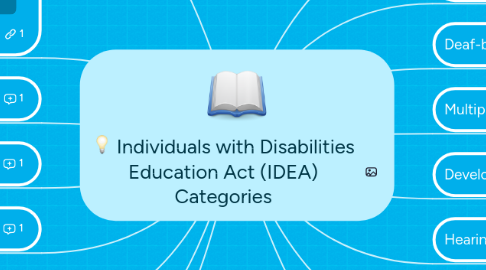
1. Specific Learning Disability
1.1. A disorder related to processing information
1.2. Difficulty in reading, writing and computing
1.3. Accommodating students
1.3.1. Record lecture to allow students with LD to replay content
1.3.2. Provide an outline, highlight learning objective
1.3.3. Assignment modification with fewer questions
1.3.4. Provide extra time for assignments and tests
1.4. Case study: Ellie, 11 year old girl
1.4.1. Cognitive deficit caused slower processing time, LD in areas of recognizing words and reading fluently, need help in reading-comprehension techniques; also display Attention deficit disorder (ADD)
1.5. Case study: Sam, 7 year old boy
1.5.1. Primary disability- Specific Learning Disability, secondary disability- other health impairment, epilepsy
1.5.2. Attended private school, received support from inclusion program and teacher
1.5.3. Discontinued his medication for epilepsy, built confidence to interact with others
2. Introduction to Special Education
3. Speech or language impairment
3.1. Difficulty to accurately producing sounds of language
3.1.1. Define actions as necessary
3.2. In other words, individuals with CD can't meaningfully communicate using language
3.3. Accommodating students
3.3.1. Simplify instructions, use simple and easy words both verbally and in written forms
3.3.2. Use visuals and allow laptops in-class
4. Intellectual disability
4.1. Occur in range of severity
4.2. Significant limitation in intellectual ability and adaptive behavior
4.3. Accommodating students with intellectual disability
4.3.1. Pay attention to student's needs more closely
4.3.2. Stick to routine, talk slowly and clearly
4.4. Case study: Jeanette and Nicole have intellectual disability, paraprofessional helped them in selected classes.
5. Emotional disturbance
5.1. Significant problems in social-emotional areas
5.2. Negatively affecting learning
5.3. Accommodating students
5.3.1. Stand close to the student, make frequent eye contact
5.3.2. Have shorter quizzes or assignments in-class
5.3.3. Use a combination of visuals, text, video presentation to engage students
6. Autism or Autism Spectrum Disorder (ASD)
6.1. Extraordinary difficulty in social responsiveness
6.2. Occur in different forms
6.2.1. mild
6.2.2. significant
6.3. Accommodating autistic students
6.3.1. Provide short and simple instructions
6.3.2. Stick to the routine, classroom management
6.3.3. Use a variety of ways to present information
6.4. Case study: Anderson, 3 year old boy
6.4.1. delayed communication development, consistent communication system called Picture Exchange Communication System developed for school and home, visual schedule and recording events from school
7. Deafness
7.1. A child is impaired in processing linguistic information through hearing
7.2. Negatively affecting school performance
7.3. Accommodating students
7.3.1. Allow the use of assistive listening device
7.3.2. Use visual and written forms of communication
8. Deaf-blindness
8.1. Causes communication, developmental and educational difficulties
8.2. Accommodating students
8.2.1. Simpler assignment
8.2.2. Use gestures
9. Orthopedic impairment
9.1. Significant impairment in ability to move or complete motor activities
9.2. Accommodating students
9.2.1. Plan activities that include writing
9.2.2. Check classroom setting
10. Traumatic Brain Injury
10.1. Impact of disability affect these areas
10.1.1. Learning
10.1.2. Behavior
10.1.3. Social skills
10.1.4. Language
10.2. Accommodating students
10.2.1. Communicate with tutor, specialist and parent to align learning objective
10.2.2. Use tools and equipment to aid learning
11. Multiple disabilities
11.1. Example: mental retardation and physical disabilities
11.2. Accommodating students with multiple disabilities
11.2.1. Ask a peer to share notes
11.2.2. Use assistive technology
12. Developmental delay
12.1. Alternative to specific disability label
12.2. Identifying students up to age 9 needing special education
12.3. Accommodating students
12.3.1. Communicate frequently with student regarding learning expectation and outcome
12.3.2. Give clear instruction for assignments both verbally and in written form
13. Hearing impairment
13.1. Adversely affects child's school performance
13.2. Accommodating students
13.2.1. Allow the use of assistive listening device
13.2.2. Break down assignment in steps
13.2.3. Use visuals and texts
14. Sources:
14.1. IDEA disability categories
14.2. Types of learning disabilities and symptoms
15. Other health impairment
15.1. Examples: Sickle cell anemia, diabetes, cancer
15.2. Accommodating students with other health impairment
15.2.1. Allow students to make up for class
15.2.2. Communicate with student via email
15.3. Case study:
16. Visual impairment
16.1. Including blindness
16.2. Accommodating students
16.2.1. Use of kinesthetic learning methods
16.2.2. Repeat instruction slowly and allow assistive technology enabling sounds
